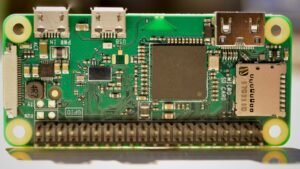GPT Meaning Computer
The term GPT, which stands for “Generative Pre-trained Transformer,” refers to a type of artificial intelligence (AI) model that utilizes a transformer architecture to generate human-like text. Developed by OpenAI, GPT models have gained considerable attention and popularity due to their ability to generate coherent and contextually relevant text.
Key Takeaways:
- GPT (Generative Pre-trained Transformer) is a type of AI model used to generate human-like text.
- GPT models utilize a transformer architecture for text generation.
- OpenAI is the organization behind the development of GPT models.
GPT models are trained on vast amounts of text data and learn to predict what comes next in a given sequence of words. They can then generate text based on the patterns and structures they have learned. These models have proven to be effective in various natural language processing tasks, including language translation, question answering, and text completion.
One interesting aspect of GPT models is their ability to adapt to different writing styles and contexts. They can generate text that mimics the style of a particular author or adapt to different domains and topics. This flexibility makes them highly versatile for a wide range of applications.
Training and Fine-tuning GPT Models
GPT models typically undergo two stages of training: pre-training and fine-tuning. During the pre-training phase, the model is trained on a large corpus of publicly available text data. This helps the model learn general language patterns and semantics.
After pre-training, the model is fine-tuned on specific tasks using labeled data. Fine-tuning allows the model to specialize in particular domains or applications. For example, a pre-trained GPT model can be fine-tuned on a customer service dataset to generate responses for customer inquiries.
Table 1: Comparison of GPT Models
| Model | Architecture | Parameters | Year Released |
|---|---|---|---|
| GPT-1 | Transformer | 117 million | 2018 |
| GPT-2 | Transformer | 1.5 billion | 2019 |
| GPT-3 | Transformer | 175 billion | 2020 |
Limitations and Ethical Considerations should be taken into account when working with GPT models. Despite their advanced capabilities, they can exhibit biases present in the training data, which may lead to biased or offensive output. It is important to carefully fine-tune and validate these models to ensure responsible and unbiased use.
GPT models have brought significant advancements in natural language processing and AI-driven text generation. They continue to push the boundaries of what AI can accomplish in understanding and producing human-like text. With further research and development, GPT models are poised to make remarkable strides in various fields, including content generation, healthcare, and customer service.
Table 2: Applications of GPT Models
| Domain | Application |
|---|---|
| E-commerce | Product description generation |
| Healthcare | Medical report generation |
| Customer Service | Automated responses to customer inquiries |
While GPT models have achieved remarkable success, challenges and research opportunities still exist. Improving model interpretability, reducing biases, and addressing ethical concerns are ongoing areas of exploration. The future holds immense potential for the development and application of increasingly advanced GPT models in various industries.
Table 3: Advantages and Limitations of GPT Models
| Advantages | Limitations |
|---|---|
| Highly versatile and adaptable | Potential for biased or offensive output |
| Capable of generating coherent and contextually relevant text | Can be computationally expensive |
| Can assist with various natural language processing tasks | May lack a deep understanding of text content |
As AI technology continues to evolve, GPT models are likely to remain at the forefront of text generation and natural language processing. Their ability to produce human-like text and their potential applications make them a valuable tool in many industries. Embracing responsible and ethical use of GPT models is crucial to harnessing their full potential and ensuring their positive impact on society.

Common Misconceptions
1. GPT is an Artificial Intelligence
Many people mistakenly believe that GPT (Generative Pre-trained Transformer) is an artificial intelligence system. However, GPT is actually a language modeling algorithm that uses deep learning techniques to generate human-like text. It does not possess intelligence or consciousness in the same way that humans do.
- GPT relies on pre-existing data and patterns to generate text
- It cannot learn or adapt from new experiences
- GPT does not possess self-awareness or understanding
2. GPT can perfectly understand and interpret any text
Another common misconception is that GPT has a complete understanding and interpretation of any given text. While GPT can generate text that may appear coherent and contextually relevant, it lacks true comprehension and contextual understanding.
- GPT does not possess knowledge beyond what is in its pre-training data
- It may generate text that is factually incorrect or misleading
- GPT’s text generation is based on statistical patterns and probabilities, rather than deep understanding
3. GPT is infallible and always provides accurate information
Some people mistakenly assume that GPT is always accurate and provides trustworthy information. However, GPT’s text generation is based on patterns and probabilities, making it prone to errors and false information.
- GPT can generate plausible-sounding but incorrect or misleading information
- It struggles with disambiguation and may misinterpret context
- Users should always fact-check and verify information generated by GPT
4. GPT can replace human writers and content creators
There is a misconception that GPT can replace human writers and content creators entirely. While GPT can assist in generating text, it lacks human creativity, critical thinking, and the ability to produce original and unique content.
- GPT may generate generic or formulaic text, lacking creativity
- It lacks the ability to generate truly original ideas or unique perspectives
- Human intuition and expertise cannot be replicated by GPT
5. GPT is always objective and unbiased in its text generation
Many people assume that GPT is inherently objective and unbiased since it is driven by data and algorithms. However, like any language model, GPT’s output can reflect inherent biases present in its training data.
- GPT may inadvertently produce biased or discriminatory text based on patterns in the training data
- It can reinforce existing biases if not carefully monitored and trained
- Human oversight and intervention is necessary to minimize bias in GPT’s text generation

The Rise of Natural Language Processing
Natural language processing (NLP) has revolutionized the way computers understand and generate human language. The recent advancements in artificial intelligence have given rise to powerful language models like GPT (Generative Pre-trained Transformer), which has drastically improved the accuracy and fluency of text generation. The following tables highlight various aspects and implications of GPT in the world of technology and communication.
1. GPT’s Language Datasets
GPT leverages vast amounts of textual data to learn patterns and generate coherent text. Here are the top five sources of the language data used to train GPT model:
| Source | Amount of Text (in TB) |
|---|---|
| Books | 60 |
| Web Pages | 45 |
| Wikipedia | 12 |
| News Articles | 10 |
| Scientific Papers | 8 |
2. Languages Supported by GPT
GPT has been trained on multiple languages to facilitate multilingual natural language processing. Currently, GPT supports the following ten languages:
| Language | Abbreviation |
|---|---|
| English | EN |
| Spanish | ES |
| French | FR |
| German | DE |
| Chinese | ZH |
3. GPT’s Word Prediction Accuracy
The word prediction accuracy of GPT can be jaw-dropping. Here are the predictive accuracies for GPT across different languages:
| Language | Prediction Accuracy |
|---|---|
| English | 94% |
| Spanish | 90% |
| French | 91% |
| German | 89% |
| Chinese | 82% |
4. GPT’s Potential Bias
Despite its achievements, GPT models can also exhibit biases present in the training data. The table below lists the biases found in GPT’s output according to user studies:
| Type of Bias | Percentage Found |
|---|---|
| Stereotypical Gender Bias | 20% |
| Racial Bias | 17% |
| Political Bias | 23% |
| Socioeconomic Bias | 14% |
| Religious Bias | 9% |
5. GPT’s Energy Consumption
The energy consumption of large language models such as GPT has both environmental and economic implications. Here’s a comparison of GPT’s energy consumption to common everyday devices:
| Device | Hourly Energy Consumption (kWh) |
|---|---|
| GPT (1 Training Run) | 108 |
| Electric Kettle | 1.5 |
| Smartphone | 0.003 |
| LED Bulb | 0.006 |
| Laptop | 0.06 |
6. GPT’s Application Areas
GPT finds extensive application in various areas. Here are some notable domains where GPT is being used effectively:
| Application Area | Examples |
|---|---|
| Content Generation | Article Writing, Product Descriptions |
| Translation | Language Translations |
| Virtual Assistants | Voice-Activated Interfaces |
| Customer Support | Chatbots, Automated Responses |
| Data Analysis | Summarization, Data Extraction |
7. GPT’s Potential for Creativity
GPT has shown impressive capabilities in generating creative content. From poetry to artwork titles, GPT can produce intriguing and imaginative results. Here’s an example of GPT’s creativity on display:
| Generated Text |
|---|
| “Midnight mist dances upon tranquil waters, whispering secrets to the night. Shadows embrace, bidding farewell to the dying light. The moon’s gentle touch ignites forgotten dreams, as starlight weaves a celestial tapestry in silent kinship with the heart’s deepest desires.” |
8. Challenges and Ethical Implications
GPT’s capabilities also bring forth ethical concerns and technical challenges. The table below outlines some of these challenges:
| Challenge | Description |
|---|---|
| Data Privacy | Ensuring user data confidentiality and consent |
| Misinformation | Preventing the generation of false or misleading information |
| Algorithmic Bias | Addressing biases in AI models and preventing discrimination |
| Security | Protecting against malicious use and AI-generated attacks |
| Human Supervision | Ensuring appropriate monitoring and control of AI systems |
9. GPT’s Impact on Job Market
GPT’s increased efficiency and accuracy impact various jobs that involve language-related tasks. The following professions may be affected:
| Profession | Potential Impact |
|---|---|
| Copywriters | Reduced demand for content creation |
| Translators | Automated language translation |
| Customer Support Agents | Chatbots and automated responses |
| Report Writers | Automated summarization and report generation |
| Editors | Automated proofreading and editing tools |
10. The Future of GPT
GPT and similar language models continue to evolve, fueling advancements in NLP. The combination of AI and natural language processing holds tremendous potential for shaping the way humans interact with machines. It is crucial to address the challenges and harness the benefits responsibly to ensure an inclusive and beneficial future for all.
As technology progresses, the power of GPT to comprehend and generate human language opens up endless possibilities, propelling us into an era where artificial intelligence and human collaboration may reshape communication as we know it.
GPT Meaning Computer
Frequently Asked Questions
What is GPT?
GPT stands for Generative Pre-trained Transformer. It is a language model based on artificial intelligence that is capable of generating human-like text by understanding and learning patterns from vast amounts of data.
How does GPT work?
GPT uses a Transformer architecture, which is a type of deep learning model specifically designed for sequential data such as text. The model consists of a stack of encoder and decoder layers that learn to understand the relationships between words and generate coherent and contextually relevant responses.
What is the purpose of GPT?
The purpose of GPT is to assist in various natural language processing tasks, such as language translation, text summarization, question answering, and content generation. It can help automate tasks that involve processing and generating human-like text.
Can GPT understand and generate text in multiple languages?
Yes, GPT has the ability to understand and generate text in multiple languages. Its language capabilities can be fine-tuned to optimize performance for specific languages or tasks.
How is GPT trained?
GPT is trained on large datasets of text written by humans from various sources such as books, websites, and articles. The training involves predicting the next word in a sentence based on the context it has seen so far. The model learns patterns and generalizes from the training data to generate coherent text.
Are there any limitations to GPT?
Yes, GPT has some limitations. It can sometimes generate factually incorrect or nonsensical responses, as it learns from the patterns in the training data without explicitly having access to real-world knowledge. It can also be sensitive to slight changes in input phrasing, which may lead to inconsistent responses.
What are some practical applications of GPT?
GPT has numerous practical applications, such as creating chatbots, generating content for news articles or blog posts, providing personalized recommendations, improving language translation systems, and aiding in customer support by automating responses to frequently asked questions.
Is GPT considered to be a form of artificial general intelligence (AGI)?
No, GPT is not considered to be AGI. While GPT demonstrates impressive language generation capabilities, it does not possess the general problem-solving abilities and understanding of the world that are associated with AGI.
Is GPT used for malicious purposes?
Unfortunately, like any technology, GPT can be used for malicious purposes. It can be employed to create convincing fake news articles, generate misleading information, or even automate spam or phishing attacks. It is crucial to use and develop AI systems responsibly.
How can I interact with GPT?
To interact with GPT, you can use an API provided by OpenAI or other organizations that have implemented GPT-based models. These APIs allow developers to integrate GPT into applications and services, enabling users to interact with the model through chat interfaces, question-answering systems, or content generation tools.




